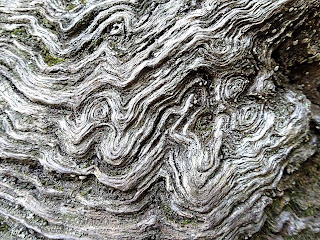*** This trail has been closed by the South Carolina State Parks, indefinitely. I do not have any additional information on this closure. Hopefully will update that it was reopened, at future date.***
After all the hype about how this will be the brightest and most beautiful autumn in decades, a couple of weeks of hot weather coupled with high winds and stormy weather has left the Upstate and Western North Carolina a little short on fall color. No doubt it was there - individual sourwoods, maples and hickories dressed in vibrant reds, yellows and oranges – but despite our multiple trips up into the mountains and foothills we were left without the technicolor dreamscapes of last year.
After all the hype about how this will be the brightest and most beautiful autumn in decades, a couple of weeks of hot weather coupled with high winds and stormy weather has left the Upstate and Western North Carolina a little short on fall color. No doubt it was there - individual sourwoods, maples and hickories dressed in vibrant reds, yellows and oranges – but despite our multiple trips up into the mountains and foothills we were left without the technicolor dreamscapes of last year.
That’s
not to say it has been a bust; I’ve enjoyed every single minute spent outdoors
this October! And on a recent hike in Devils Fork State Park I was reminded
that it’s not only about fall color and high-elevation views this time of year…
it’s about getting out on the trail with the kids, even on those chilly
mornings that you would rather sit back with a cup of coffee while they busy
themselves with Legos.
Bear
Cove Trail is one of two trails at Devils Fork State Park, the other being the
1.5-mile Oconee Bell Trail which starts near the Ranger Station. The trailhead
for the 2.5 mile Bear Cove lollipop-loop is on the other side of Devils Fork,
off the parking area next to Concessions and the playground. The online maps
don’t show the entire trail, so if you would like a map either head over to the
SC Trails website or ask at the Park Visitor Center.
We packed
up our backpacks and headed into the forest following the blue blazes, soon
crossing Turkey Ridge Road (that leads to the campground) and then starting the
loop portion of the hike. Although it was predominantly hardwoods throughout
our hike, there just wasn’t much color; either it was too early, or the
temperature fluctuations/weather had dulled the colors. The red maples and
dogwoods were brighter shades of red, suggesting there is still hope despite
all the brown foliage already underfoot.
We hiked the loop clockwise; this puts the Lake Jocassee overlook past the halfway point of the hike making it a logical lunch stop. The trail heads out onto a finger of land between two inlets, and although I’m not sure which one is Bear Cove (if either!), across the water to the north is the Devils Fork SP Dive Training Site, while the peninsula to the south is where the walk-in campground is, accessible from behind the playground on Buckeye Drive. The trail took us almost right out to the tip of the peninsula, and after scrambling down the rocky bank we found ourselves surrounded by the blue waters of Lake Jocassee on three sides.
The
water level seemed low, about 10 feet lower than the lines visible on the shores.
This is most obvious back at the swimming area, where 30 feet of beach has been
revealed by the retreating waters, however it was easy to see that the rocky
point we were standing on sometimes is visible only through the blue waters of the
lake. A little further on the trail is a bench and signage describing the
history of the valley, and beyond that is a path down to a little beach where
we spent some time skipping stones.
Bear
Cove was ideal for a short autumn hike, as we made it back to the parking lot
with plenty of time to spare despite our leisurely pace on the trail – about 2
hours including the lunch stop. The views of Lake Jocassee more than made up
for the lack of fall color, although if we were to return today it might be a
different story; cooler temperatures and several inches of rain have no doubt
influenced the foliage as well as lake levels. We packed up the car and then
took one last stroll over to the shore near the swimming area for an final look
out over the blue waters of Jocassee. I always find the view bittersweet as I
think of all that was lost when the valley was flooded, and these losses hard
to reconcile with the beauty of Jocassee that is visible today.
_________
Devils
Fork State Park website here
My
previous post on the park here
More on the Oconee Bell Trail here
Your Guide to the Cherokee Foothills Scenic Highway 11 here...
and a post
on the other end of Lake Jocassee and Jumping Off Rock here.



















































